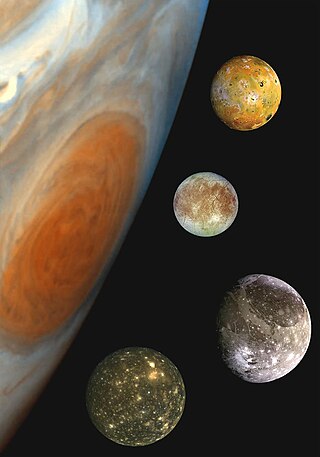
The Galilean moons, or Galilean satellites, are the four largest moons of Jupiter: Io, Europa, Ganymede, and Callisto. They are the most readily visible Solar System objects after the unaided visible Saturn, the dimmest of the classical planets, allowing observation with common binoculars, even under night sky conditions of high light pollution. The invention of the telescope enabled the discovery of the moons in 1610. Through this, they became the first Solar System objects discovered since humans have started tracking the classical planets, and the first objects to be found to orbit any planet beyond Earth.
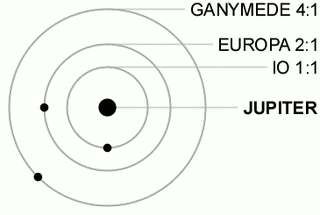
In celestial mechanics, orbital resonance occurs when orbiting bodies exert regular, periodic gravitational influence on each other, usually because their orbital periods are related by a ratio of small integers. Most commonly, this relationship is found between a pair of objects. The physical principle behind orbital resonance is similar in concept to pushing a child on a swing, whereby the orbit and the swing both have a natural frequency, and the body doing the "pushing" will act in periodic repetition to have a cumulative effect on the motion. Orbital resonances greatly enhance the mutual gravitational influence of the bodies. In most cases, this results in an unstable interaction, in which the bodies exchange momentum and shift orbits until the resonance no longer exists. Under some circumstances, a resonant system can be self-correcting and thus stable. Examples are the 1:2:4 resonance of Jupiter's moons Ganymede, Europa and Io, and the 2:3 resonance between Neptune and Pluto. Unstable resonances with Saturn's inner moons give rise to gaps in the rings of Saturn. The special case of 1:1 resonance between bodies with similar orbital radii causes large planetary system bodies to eject most other bodies sharing their orbits; this is part of the much more extensive process of clearing the neighbourhood, an effect that is used in the current definition of a planet.

Tidal acceleration is an effect of the tidal forces between an orbiting natural satellite and the primary planet that it orbits. The acceleration causes a gradual recession of a satellite in a prograde orbit, and a corresponding slowdown of the primary's rotation. The process eventually leads to tidal locking, usually of the smaller body first, and later the larger body. The Earth–Moon system is the best-studied case.

Europa, or Jupiter II, is the smallest of the four Galilean moons orbiting Jupiter, and the sixth-closest to the planet of all the 95 known moons of Jupiter. It is also the sixth-largest moon in the Solar System. Europa was discovered independently by Simon Marius and Galileo Galilei and was named after Europa, the Phoenician mother of King Minos of Crete and lover of Zeus.

A natural satellite is, in the most common usage, an astronomical body that orbits a planet, dwarf planet, or small Solar System body. Natural satellites are colloquially referred to as moons, a derivation from the Moon of Earth.
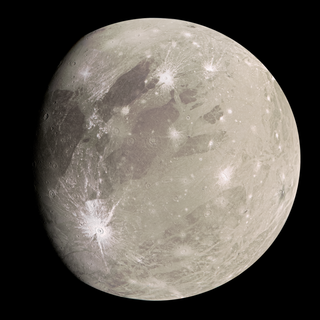
Ganymede, or Jupiter III, is the largest and most massive natural satellite of Jupiter as well as the largest in the Solar System, being a planetary-mass moon. It is the largest Solar System object without an atmosphere, despite being the only moon in the Solar System with a substantial magnetic field. Like Titan, Saturn's largest moon, it is larger than the planet Mercury, but has somewhat less surface gravity than Mercury, Io or the Moon due to its lower density compared to the three.

Tidal locking between a pair of co-orbiting astronomical bodies occurs when one of the objects reaches a state where there is no longer any net change in its rotation rate over the course of a complete orbit. In the case where a tidally locked body possesses synchronous rotation, the object takes just as long to rotate around its own axis as it does to revolve around its partner. For example, the same side of the Moon always faces the Earth, although there is some variability because the Moon's orbit is not perfectly circular. Usually, only the satellite is tidally locked to the larger body. However, if both the difference in mass between the two bodies and the distance between them are relatively small, each may be tidally locked to the other; this is the case for Pluto and Charon, as well as for Eris and Dysnomia. Alternative names for the tidal locking process are gravitational locking, captured rotation, and spin–orbit locking.

Hot Jupiters are a class of gas giant exoplanets that are inferred to be physically similar to Jupiter but that have very short orbital periods. The close proximity to their stars and high surface-atmosphere temperatures resulted in their informal name "hot Jupiters".
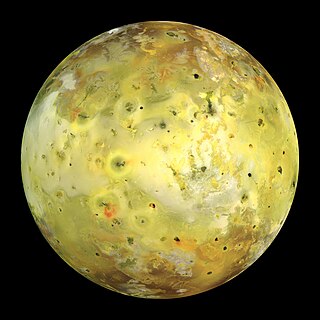
Io, or Jupiter I, is the innermost and third-largest of the four Galilean moons of the planet Jupiter. Slightly larger than Earth's moon, Io is the fourth-largest moon in the Solar System, has the highest density of any moon, the strongest surface gravity of any moon, and the lowest amount of water of any known astronomical object in the Solar System. It was discovered in 1610 by Galileo Galilei and was named after the mythological character Io, a priestess of Hera who became one of Zeus's lovers.

An exomoon or extrasolar moon is a natural satellite that orbits an exoplanet or other non-stellar extrasolar body.
In celestial mechanics, the Kozai mechanism is a dynamical phenomenon affecting the orbit of a binary system perturbed by a distant third body under certain conditions. It is also known as the von Zeipel-Kozai-Lidov, Lidov–Kozai mechanism, Kozai–Lidov mechanism, or some combination of Kozai, Lidov–Kozai, Kozai–Lidov or von Zeipel-Kozai-Lidov effect, oscillations, cycles, or resonance. This effect causes the orbit's argument of pericenter to oscillate about a constant value, which in turn leads to a periodic exchange between its eccentricity and inclination. The process occurs on timescales much longer than the orbital periods. It can drive an initially near-circular orbit to arbitrarily high eccentricity, and flip an initially moderately inclined orbit between a prograde and a retrograde motion.
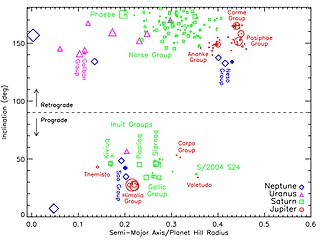
In astronomy, an irregular moon, irregular satellite or irregular natural satellite is a natural satellite following a distant, inclined, and often eccentric and retrograde orbit. They have been captured by their parent planet, unlike regular satellites, which formed in orbit around them. Irregular moons have a stable orbit, unlike temporary satellites which often have similarly irregular orbits but will eventually depart. The term does not refer to shape; Triton for example, is a round moon, but is considered irregular due to its orbit.

There is evidence that the formation of the Solar System began about 4.6 billion years ago with the gravitational collapse of a small part of a giant molecular cloud. Most of the collapsing mass collected in the center, forming the Sun, while the rest flattened into a protoplanetary disk out of which the planets, moons, asteroids, and other small Solar System bodies formed.

The habitability of natural satellites is the potential of moons to provide habitats for life, though it is not an indicator that they harbor it. Natural satellites are expected to outnumber planets by a large margin and the study of their habitability is therefore important to astrobiology and the search for extraterrestrial life. There are, nevertheless, significant environmental variables specific to moons.
The stability of the Solar System is a subject of much inquiry in astronomy. Though the planets have historically been stable as observed, and will be in the "short" term, their weak gravitational effects on one another can add up in ways that are not predictable by any simple means.

In astronomy, a regular moon or a regular satellite is a natural satellite following a relatively close, stable, and circular orbit which is generally aligned to its primary's equator. They formed within discs of debris that surround their primary, usually the aftermath of a large collision or material accumulated from the protoplanetary disc. These debris discs then accrete into regular moons, as opposed to irregular moons, which were captured.

Retrograde motion in astronomy is, in general, orbital or rotational motion of an object in the direction opposite the rotation of its primary, that is, the central object. It may also describe other motions such as precession or nutation of an object's rotational axis. Prograde or direct motion is more normal motion in the same direction as the primary rotates. However, "retrograde" and "prograde" can also refer to an object other than the primary if so described. The direction of rotation is determined by an inertial frame of reference, such as distant fixed stars.

A lava planet is a type of terrestrial planet, with a surface mostly or entirely covered by molten lava. Situations where such planets could exist include a young terrestrial planet just after its formation, a planet that has recently suffered a large collision event, or a planet orbiting very close to its star, causing intense irradiation and tidal forces.
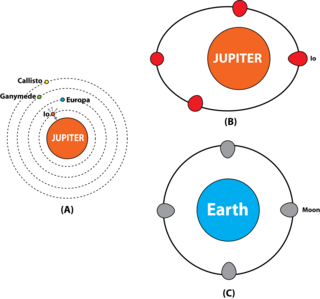
Tidal heating of Io occurs through the tidal friction processes between Jupiter and its moon. Orbital and rotational energy are dissipated as heat in the crust of the moon. Io has a similar mass and size as the Moon, but Io is the most geologically active body in the Solar System. This is caused by the heating mechanism of Io. The major heating source of Earth and the Moon is radioactive heating, but the heating source on Io is tidal heating. As Jupiter is very massive, the side of Io nearest to Jupiter has a slightly larger gravitational pull than the opposite side. This difference in gravitational forces cause distortion of Io’s shape. Differently from the Earth’s only moon, Jupiter has two other large moons that are in an orbital resonance with it. Io is the innermost of this set of resonant moons, and their interactions maintain its orbit in an eccentric (elliptical) state. The varying distance between Jupiter and Io continually changes the degree of distortion of Io's shape and flexes its interior, frictionally heating it. The friction-induced heating drives strong volcanic activities on the surface of Io.

A satellite system is a set of gravitationally bound objects in orbit around a planetary mass object or minor planet, or its barycenter. Generally speaking, it is a set of natural satellites (moons), although such systems may also consist of bodies such as circumplanetary disks, ring systems, moonlets, minor-planet moons and artificial satellites any of which may themselves have satellite systems of their own. Some bodies also possess quasi-satellites that have orbits gravitationally influenced by their primary, but are generally not considered to be part of a satellite system. Satellite systems can have complex interactions including magnetic, tidal, atmospheric and orbital interactions such as orbital resonances and libration. Individually major satellite objects are designated in Roman numerals. Satellite systems are referred to either by the possessive adjectives of their primary, or less commonly by the name of their primary. Where only one satellite is known, or it is a binary with a common centre of gravity, it may be referred to using the hyphenated names of the primary and major satellite.


























